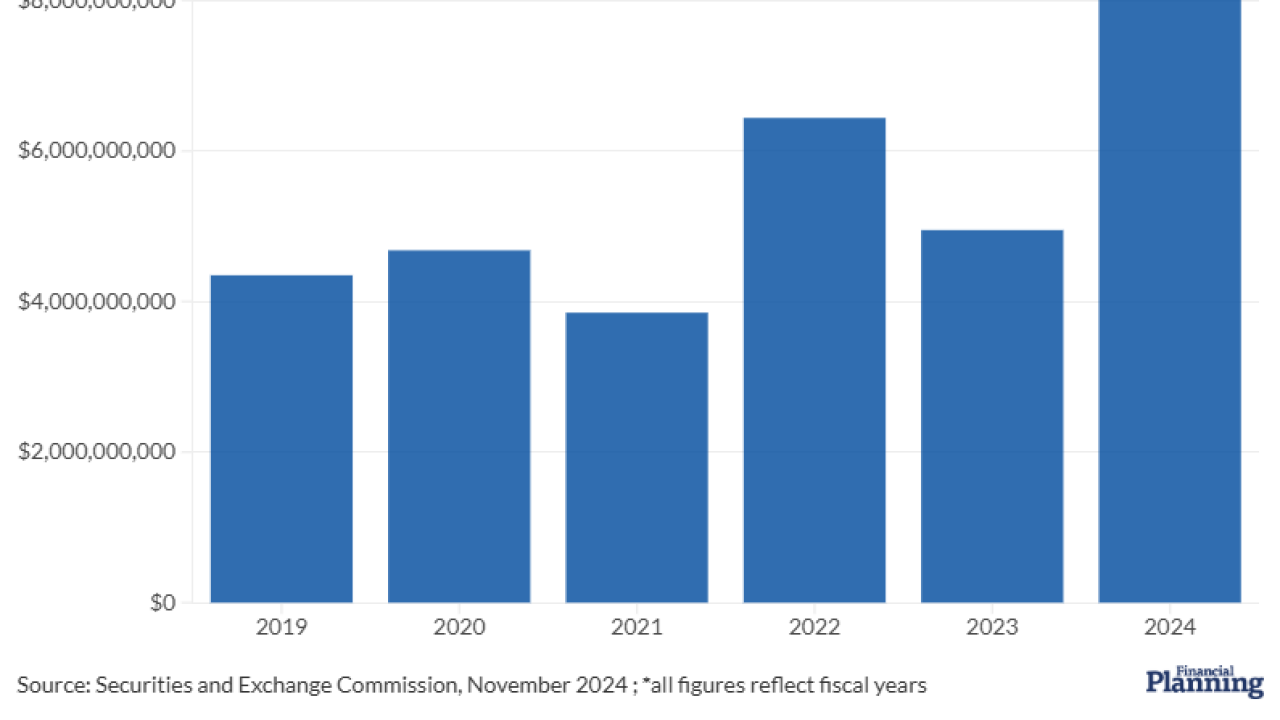The RIA sector is enjoying brisk growth in both personnel and assets under management, but remains dominated by small businesses that cater to specialized sets of clients, including a growing number of firms that are rolling out interactive digital advice services.
Those are among the findings from a new
In a statement, IAA President and CEO Karen Barr touted the industry's flexibility, noting the continued growth amid the "rapid pace of change in the financial services ecosystem."
John Geibauer, president of National Regulatory Services, says that the industry's embrace of technology is "both a response to client needs and expectations and a driver that is expanding the client base for financial advice."
By the numbers, the RIA sector reached an all-time high with 12,172 SEC-registered advisers as of April 2017, up 2.7% from a year ago. Those advisers serve 35.6 million clients and manage $70.7 trillion in assets, according to the IAA's analysis.

The total number of clients served, while down a tick from 2016 (which the IAA attributes in part to changes in methodology and a reporting error, saying that the slight decline is "not meaningful"), continues a running trend of increases. In 2012, SEC-registered advisers reported serving 23.2 million clients, more than 13 million fewer than today.
By firm count, the growth of the RIA sector stands in sharp contrast to the diminishing number of brokerage houses, though industry consolidation in the broker-dealer world is a mitigating factor. Still, the number of RIA firms eclipsed FINRA-registered brokers in 2014, and the trend lines have been diverging since. The IAA posits that still more brokers might move toward the adviser model in response to the Department of Labor's fiduciary regulation.
THE RISE OF ROBOS
But the IAA suggests that much of the client growth has been fueled by the rise of digital advice platforms, both those that serve retirement plan participants and the online robo services and apps that cater to retail clients with lower account balances.
"The past couple of years we've been looking at the trend toward automated investment advice," Laura Grossman, the IAA's assistant general counsel who led the team that assembled this year's report, said in an interview. "The form (ADV) is not designed to pull out that information so it's a little hard to tell, but it seems like that's increasing."
But Form ADV does have a box for firms to check to indicate that they are an "Internet adviser," a more than 10-year-old designation that covers firms that provide advice almost exclusively through an online platform. (Firms can still be eligible for that designation if they provide additional advice beyond their website to fewer than 15 clients in a year.)
The number of firms that checked that box has been on the rise in recent years, up 16% this year and just under 60% from 2015 to 2016. That's still a tiny fraction of the overall RIA universe, however, with only 146 firms self-identifying as internet-only this year. What's more, 61 of those firms are registered with the SEC but do not report any clients or assets under management, amounting to what the IAA calls "shelf registrations," according to Grossman.
"They're probably expecting to get the assets or get the clients in the future," Grossman says. She cautions against allowing the internet-only channel to obscure the far larger shift toward some hybrid form of service model that blends automated advice with human elements.
"I wouldn't just look at the internet-only adviser -- the 146. That does not even encompass what we see as the major robo players," Grossman says.
The firm isn't the only one benefiting from a still strong breakaway movement.
"That's not representative of what we consider automated investment advice," she says, noting that major robo players like Betterment or Vanguard wouldn't identify as strictly automated firms on their Form ADV. "They don't check the box for internet-only."
The data show that there are only a handful of mega-advisers serving a vast portfolio of clients, suggesting a heavy reliance on an automated advice platform. Just eight registrants report that they have more than 1 million clients.
Far more common are firms that have fewer than 100 clients, the analysis finds. In part, though, that number is weighed down by the advisers who serve a relatively small number of pooled vehicles such as mutual funds or private funds.
It is also reflective of the fact that most RIAs are small-scale operations, with relatively few employees serving a proportionate number of clients. By far the largest segment of firms are those with AUMs between $100 million and $1 billion (56% of all registrants), and 87% of all registrants count fewer than 50 employees. Slightly more than half of all firms hire 10 or fewer non-clerical employees.
"We still see that the investment adviser industry is really driven by small businesses," Grossman says.
Then again, while the smaller firms hold the lion's share of clients, there is a striking imbalance in the distribution of assets, an effect the IAA calls the "industry barbell." Just 1% of registered advisers -- only 124 -- boast an AUM of $100 billion or more, yet those shops manage 54% of the total assets in the industry.
Many advisers also demonstrate a singular mindedness in their ADV filing, both in business model and in the types of client they prefer to work with. On one side, the numbers of advisers who are either dually registered as a broker-dealer or who work as a registered rep for a broker are dwindling, down 1% and 5%, respectively.
Then, more than 87% of advisers say that one type of client comprises the majority of their business. Fifty-one percent say that they primarily serve individual clients, while 29% mostly work with some variety of pooled vehicles. Nearly 2,200 registrants say that they work exclusively with private funds, and another nearly 300 report that solely provide advice for registered funds.
"A lot of advisers specialize in a single type of client," Grossman says. "If you're an adviser, you tend to specialize."






